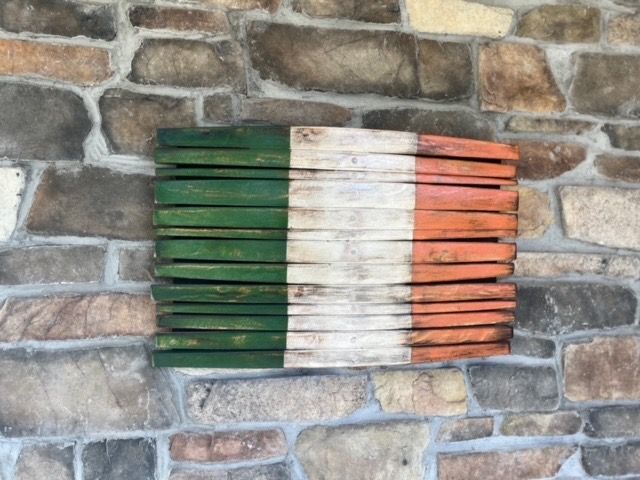Mark Connelly, author of "The IRA on Film and Television: A History"
Page Turner / Edited by Peter McDermott
"If Hollywood has failed to capture the nature of the true IRA," said author Mark Connelly, "it has nevertheless created a cinematic archetype. Like the American outlaw, the Irish rebel can be cast as hero, victim or villain.
"Many Hollywood films use the Troubles simply as a backdrop for action/adventure plots that have little bearing on the actual struggle in the North," said Connelly, who is the vice-president of the Irish Cultural and Heritage Center in Milwaukee.
"Notably missing in almost all IRA films are unionists, so that audiences are given a largely nationalist narrative, depicting the conflict as one between 'occupied' Irish Catholics and the British government," said the author of "The IRA on Film and Television: A History."
In contrast to British films, which usually contain a speech condemning the "sick ideology" of the IRA, Hollywood doesn't question the legitimacy of the "cause," while "violence and terrorism in countless films - 'Ronin,' 'Blown Away,' 'Patriot Games' - are ascribed to fringe groups or rogue loners rather than the IRA itself."
But to broaden a film's appeal, rebels are often portrayed as gangsters. "The alternative title for 'Odd Man Out' [1947] was in fact 'Gang War,'" Connelly said, referring to one of the most famous IRA-themed movies.
However, perhaps the most striking feature about his topic is the sheer volume of films involved. "Although historically a small organization dedicated to a sectarian struggle in a small nation, the IRA has commanded an unprecedented worldwide screen presence," Connelly said.
Not only have there been more than 80 motion pictures, some directed by and starring the biggest names of their time, there have been numerous TV treatments, including in classic American dramas like "Columbo," "Hawaii Five-O" and "Law & Order."
Connelly, who teaches at literature and film at Milwaukee Area Technical College, said the book takes a "history vs. Hollywood" approach from the 1916 Easter Rising through to the peace process of the 1990s. "Topics include America's role in creating both the IRA and its cinematic image," he said, "the organization's brief association with the Nazis and critical reception of IRA films in Ireland, Britain and the United States. Two classic films - 'The Informer' [1935] and 'Odd Man Out' - are examined in depth."
The author added: "Two of the strangest IRA-related films were directed by Max Kimmich in Germany in WWII. Unlike Hollywood depictions of a charming Emerald Isle, Kimmich's Ireland resembles the Transylvania of a Dracula movie characterized by dark mists, treacherous bogs and grim torch-bearing peasants. 'Der Fuchs von Glenarvon' ends with Irish rebels singing about freedom from foreign oppression, an odd propaganda vehicle for the Nazis then occupying half of Europe.
"’Mein Leben fur Irland' includes scenes of street fighting in Dublin in 1921. Shot in a German studio, these sequences achieved realism with tragic consequences. Several extras were killed and others wounded when they accidentally triggered explosive charges," said Connelly of that film, the plot of which had an Irish-American student falsely accused of treachery. "Unaware of the accident unfolding before him, the assistant director continued filming and reportedly some of footage was used in the final print."
For more details go to: www.theiraonfilmandtelevision.com.
THE MARK CONNELLY FILE
Date of birth: July 8, 1951
Place of birth: Philadelphia, raised in New Jersey, moved to Wisconsin in high school.
Residence: The Blatz, Milwaukee, (the former Blatz Brewery, now condo)
Other published works include: "The Hardy Boys Mysteries 1927-1979: A Cultural and Literary History" ( McFarland, 2008); "Fifteen Minutes" (Texas Review Press, 2005); "Deadly Closets: The Fiction of Charles Jackson," (University Press of America, 2000); "Orwell and Gissing," (Lang, 1997); "The Diminished Self: Orwell and the Loss of Freedom" (Duquesne University Press, 1987).
What is your writing routine? Are there ideal conditions?
I work early in the morning before daylight fueled by hot coffee and cold Diet Coke.
What advice do you have for aspiring writers?
Remember that all stories are told in humble sentences.
Name three books that are memorable in terms of your reading pleasure.
"The Great Gatsby"; "Long Day's Journey into Night"; "Humboldt's Gift."
What book are you currently reading?
"Paradise Lost" by Odets (this 1935 play about an idealistic small manufacturer losing his business to bankruptcy and home to foreclosure is sadly relevant in 2012).
Is there a book you wish you had written?
With the 50th anniversary of the Cuban Missile Crisis this year, it would be fascinating to learn how other nations responded. What did leaders in Ireland, Italy, Japan, and Egypt think of the U.S./Soviet confrontation? Did they make contingency plans for how their nations would respond to a global nuclear war? The need to examine classified documents would make this a difficult task, but I think it would produce a remarkable book.
Name a book that you were pleasantly surprised by.
"The Pawnbroker" by Edward Wallant
If you could meet one author, living or dead, who would it be?
Eugene O'Neill or Saul Bellow.
What book changed your life?
Too many to list.
What is your favorite spot in Ireland?
Monaghan (my great-great grandparents left in 1851).
You're Irish if...
you know the county your family came from, have read at least one book by James Joyce, and can pronounce "Taoiseach."
You're halfway Irish if....
you refuse to wear a funny green hat on St. Patrick's Day but get drunk anyway.
You're annoyingly Irish if...
you say "Twenty-Six Counties" and insist on referring to the Second World War as "the Emergency."











